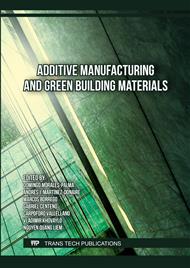p.3
p.13
p.23
p.33
p.41
p.51
p.61
p.71
Parametric Study of Functional Components Obtained by Additive Manufacturing Fused Filament Fabrication
Abstract:
Fused Filament Fabrication (FFF) is a growing additive manufacturing technology for various applications in the engineering field. The mechanical properties of 3D printed materials in FFF technology depends on various parameters and the literature suggests that infill pattern and infill density are the parameters that most affect the mechanical properties of 3D printed parts.These factors have direct influence on the time of production and amount of material used. In this work it was analyzed the influence of infill parameter on stiffness of the final parts, considering the printing time and amount material used. For this purpose, the Taguchi method was used and then the statistical method of ANOVA to calculate the influence of each parameter.Test specimens were printed according to ASTM Standard D790 dimensions, in Polyethylene terephthalate glycol (PETG). The specimens were printed in the same position on the printing bed to reduce as much as possible the influence of external factors on the results. A visual and dimensional inspection of the specimens was carried out for further analysis. The best combination between production and stiffness, with 350 MPa/mm, was obtained with 15% infill density, concentric pattern, 45º orientation, with 4 perimeters path, layer thickness of 0.1 mm and speed of 45 mm/s. The results obtained allow us a broader view of how to save 3D printing time and the amount of material consumed during the production of a part.
Info:
Periodical:
Pages:
33-40
Citation:
Online since:
September 2023
Authors:
Keywords:
Price:
Сopyright:
© 2023 Trans Tech Publications Ltd. All Rights Reserved
Share:
Citation:



